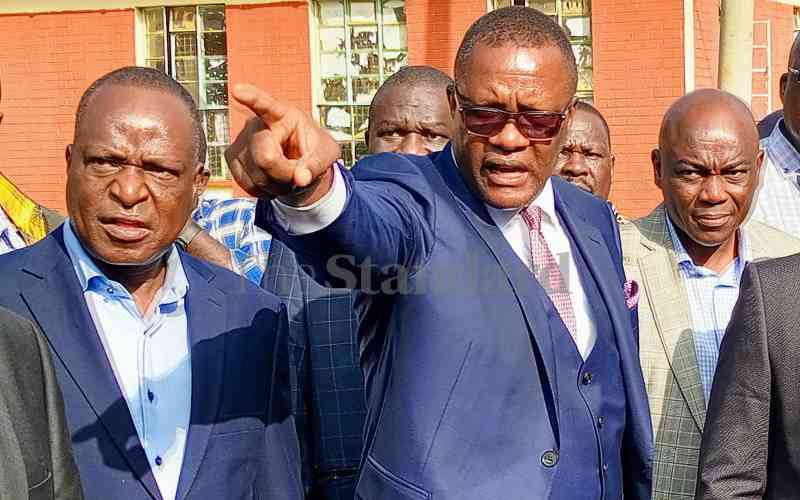
President William Ruto’s regime has for the last nine months enjoyed a love-hate relationship with the media.
If recent pronouncements by the executive are anything to go by, the future is grim.
Predictably, the relations started to sour when the media relentlessly criticised the government. In what has been a case of the current administration shooting the messenger, high-ranking officials have repeatedly told off the media for exposing the rot in government with the latest onslaught coming from Trade CS Moses Kuria.
Kuria castigated a section of media shortly after an expose on how people with links to the government were single-sourced to procure edible oils under the Kenya National Trading Corporation (KNTC) was aired.
He threatened to cut government advertising with media – a move aimed at crippling the fourth estate’s operations, but one that saw him reprimanded by his boss and Deputy President Rigathi Gachagua.
True intentions
A recent revelation by Information Communication and Technology CS Eliud Owalo that the state now plans on cutting down the costs of media advertising further exposed the government’s true intentions.
“It is not the role of government to finance the media. It so happens that the government has to build advertising in the media, but the government cannot be the single source of revenue for the media.
“You must think outside the box...If anything without the box. You cannot continue doing your business the way you used to. And you cannot look at the government as the single source of revenue for the media,” Owalo said.
“…I don’t see why the government should continue spending the amount of money that is spent on advertisement revenue. We are going to reengineer that space completely in the not-too-distant future. But note that we are not against the media, only that we have to respond to emerging issues in their environment, including but not limited to technology,” he added.
Despite clarifying that the move was not meant to cripple media and that the government respects the freedom of expression, the CS accused the media of being biased in reporting.
He alleged that it supported President William Ruto’s opponent in the August 2022 election.
“Let’s face reality. I believe that the media is still facing a hangover from the last elections. The media was not impartial at all during the last elections. And it seems that the media up to today has still not accepted that the candidate that they supported did not win.”
Survival
His claims that the media was largely relying on the government for survival are largely not factual as the government spending on media advertising accounts for about 10 per cent of media revenue.
Owalo’s assertion that government advertisements will be circulated through Postal Corporation of Kenya appeared to contradict his stance that the President was running a paperless government.
Owing to the disruption by technology, PCK’s core mandate postal services has been dealt a crippling blow by technology which has rendered most of its services obsolete and its employees going for months without pay.
The anticipated move by Owalo is reminiscent of another in 2017 when the former President Uhuru Kenyatta regime withdrew advertising revenue from mainstream media.
The Uhu-Ruto duo launched the MyGov pull out which carried all advertisements from government agencies which was a deviation from normal practice where various government agencies and department independently chose where and when to advertise.
Tension
The state also established the Government Advertising Agency to coordinate the same amid heightened tension between the media and government. The move cost the media approximately Sh2 billion in advertising revenue forcing mainstream media houses to think of and implement new revenue raising measures.
Ruto’s government is however not the first to have an acrimonious relationship with the media as history reveals.
Over the years, governments have employed various tactics to try to control the media as was the case in 2018, when the state cut off transmission from some of the country’s private TV stations including Citizen TV, Inooro TV, NTV, and KTN to stop them from airing live the swearing-in ceremony of the opposition leader Raila Odinga as the “people’s president.” In 2006, mercenaries raided Standard Group offices at I&M building, switched off the lights and CCTV cameras. They also immobilised the lifts before detaining and harassing journalists.
The balaclava-clad men then destroyed broadcasting equipment and put KTN off air. They vandalised the offices and confiscated broadcasting equipment and computers. They then proceeded to the Likoni Road office where they vandalised the press machines and torched copies of the day’s newspapers.
Leaked US cables released by the whistle-blowing website, Wikileaks, later revealed that the late John Michuki who was the Internal Security minister, had ordered the raid.
The cables released by the US Embassy in Nairobi also revealed that the attack was believed to have been coordinated by two Armenian mercenaries, the so-called Artur brothers - Artur Margaryan and Artur Sargasyan.
Michuki had said the media house was attacked as it was planning to publish and broadcast a series of stories that were damaging to the government, and that would compromise national security.
He said: “If you rattle a snake (the Government), you must be prepared to be bitten.”
The incident came a year after First lady Lucy kibaki in May 2005 stormed Nation Media Group’s offices protesting what she called negative media coverage.
It remains to be seen if the current regime will keep its promise of upholding press freedom.
newsdesk@standardmedia.co.ke